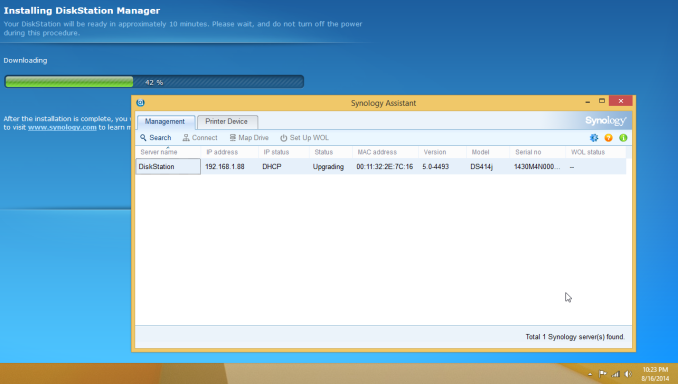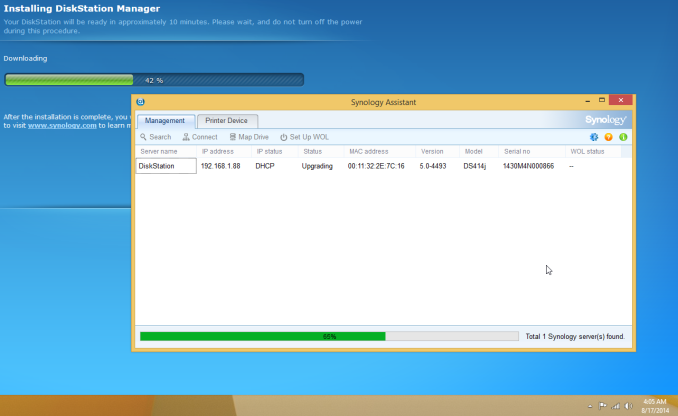Recovering Data from a Failed Synology NAS
by Ganesh T S on August 22, 2014 6:00 AM ESTDS414j Status: Disk Problems or Hardware Failure?
After ensuring the safety of the data, I tried to reinitialize the NAS using the same drives, but the process conked out towards the end with a message indicating that the process was incomplete and telnet service had been enabled for support personnel to look into. Not satisfied with this situation, I rebooted the unit with the drives removed and the reset button at the back pushed in. After the reboot, I inserted two fresh drives and began the initialization process.
DSM Initialization Process 3 Hours After Starting
DSM Initialization Process More than 8 Hours After Starting
The completion process was stuck at 42% with the second drive's LED blinking continuously for more than 48 hours before I pulled the plug. Synology Assistant had shown the status of the unit as 'Upgrading' the whole time.
Synology support asked me to try initializing with a single drive (completely new, fresh out of the box) in another bay. This changed the failure symptom, but didn't resolve the issue.
The unit was shipped back to Synology and they found that one of the circuit board elements had simply died (no burn-out or any other marks). So, it did turn out to be an internal hardware failure in the end. A small percentage of products shipped by any vendor invariably fails in the early stages of being in the consumer's hands. It was just unfortunate for Synology that it happened to a review unit sampled to the press.













55 Comments
View All Comments
Impulses - Friday, August 22, 2014 - link
While I generally agree with your logic (having never given my desktop up as my primary system, and being single), saying "just plug the laptop in via TB" or whatever isn't exactly a viable alternative for many users.I don't own a NAS, but it seems to me the biggest market for units are laptop dependant and/or multi-user households... When you have a couple and possibly kids each with their own laptop it's much easier to have a centralized media store in a NAS than anything directly attached.
Gigaplex - Saturday, August 23, 2014 - link
"A consumer can just buy high availability as a service (such as from Amazon services)"Not on ADSL2+ when dealing with multiple TBs of data I can't.
wintermute000 - Saturday, August 23, 2014 - link
QFTWHangFire - Friday, August 22, 2014 - link
Losing a day's work is considered acceptable in most environments. In theory yesterday (or last Friday) is fresh in everyone's mind, and the raw source material (emails, experimental data, FAXes, etc.) are still available in their original form to redo any data entry.What is interesting about the QSync situation is the cascading affect of failures. If caught early, through log examination, dashboards, whatever, true disaster can be averted. If minor issues like sync fails are allowed to continue, and RAID failure follows, say, a month later, then a month's worth of work can be lost. That is not acceptable in any environment.
Kougar - Friday, August 22, 2014 - link
Thanks for the article! I have a ~6 year old TS-409 Pro that is still running great, but internal component failure has been on my mind for awhile now. I'll be bookmarking this in case I ever need to use recovery options on it as I wasn't aware of either of these tools!kmmatney - Friday, August 22, 2014 - link
Nice article! I use a WHS 2011 server, with Stablebit DrivePool for redundancy. The nice thing about Drivepool is that the drives are kept in standard NTFS format. You can just take the drive out, and plug it into any computer to retrieve files, so data recovery is a piece of cake.Impulses - Friday, August 22, 2014 - link
Shame WHS is now RIPDanNeely - Friday, August 22, 2014 - link
Yeah. I'm really hoping ZFS or Btrfs NASes (without huge price premiums) will be available in the next year and a half as reasonable replacements for my current WHS 2011 box.Impulses - Friday, August 22, 2014 - link
That'd be nice, I never bought my own but I recommended and set up several for various clients & family members with small businesses...No clue what I'd tell them to migrate to right now if one were to break down, the ease of recovery and expansion was one of the biggest draws to WHS and in fact the reason many picked it over cheaper NAS boxes.
Gigaplex - Saturday, August 23, 2014 - link
There's a reason it was killed off. It has some serious design flaws that trigger data corruption, and Microsoft couldn't figure out how to resolve them. It has great flexibility but I wouldn't trust it with my data.